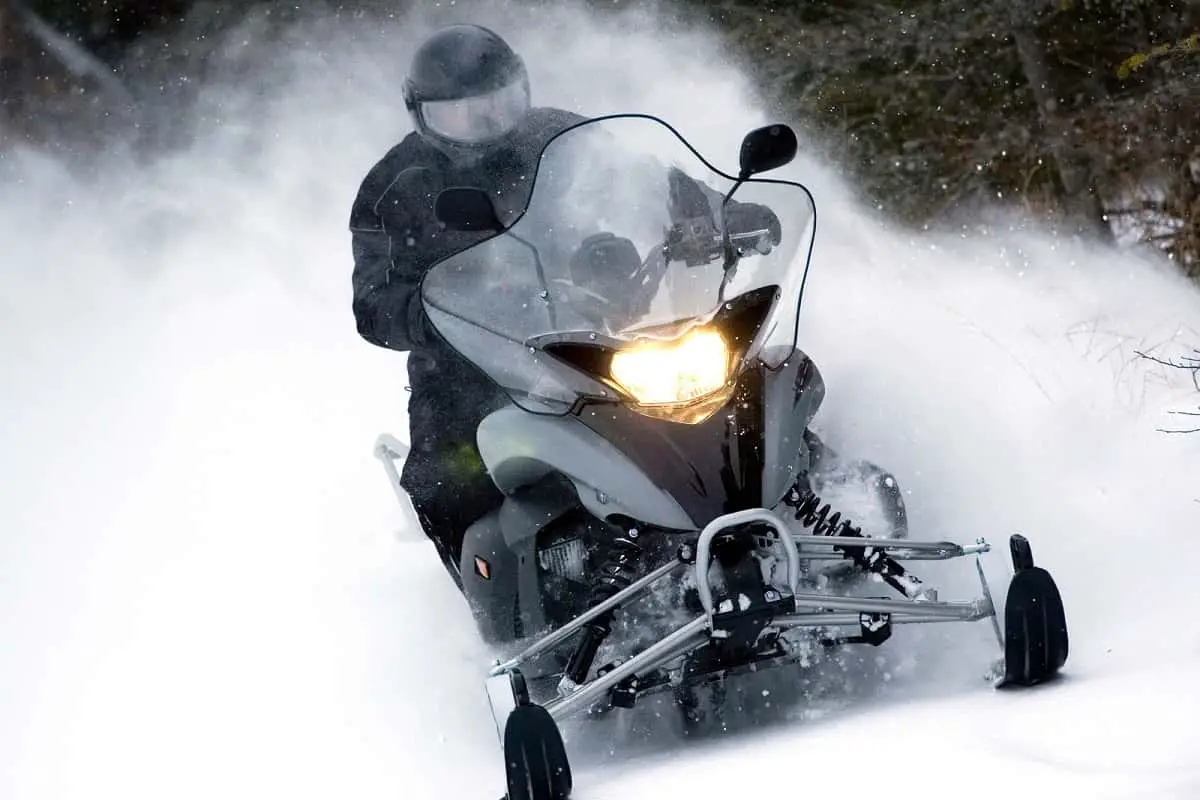How to Keep Snowmobile Helmet From Fogging
A foggy helmet visor isn’t just annoying, it can be downright dangerous, especially if you are racing competitively in a snowmobile.
Fortunately, there are a number of solutions available to stop your snowmobile helmet visor from fogging.
In this article we take a look at several different methods so you know how to keep snowmobile helmet from fogging simply by understanding what causes this problem in the first place then by taking necessary action to prevent it from happening.
KEY TAKEAWAYS
* Helmet fog is caused by your warm breath on a cold visor/shield.
* Good helmet ventilation is the key to a fog-free visor/shield.
* There are several methods to achieve a fog free visor outlined below.

Disclosure: As an Avantlink and Amazon Associate, we earn from qualifying purchases. Disclosure Statement.
Page Content
What Causes Helmet Visor Fogging?
To prevent your snowmobile helmet visor from fogging, we need to understand what causes the fogging in the first place.
One minute you’re looking through a nice clear visor, then the next thing you know it’s covered in fog and you can’t see a thing. Huh! What the heck just happened?
RELATED: Best Snowmobile Helmets With Heated Shield
So first, let’s look at why your visor gets foggy, once we know why it’s happening then we can easily form a strategy to keep your helmet shield fog-free!

Remember when you were a kid and how amazed you were when you exhaled on a cold winter’s day. It was like there was a blast of fog or smoke coming straight out of your mouth. Then you’d pretend that you were smoking a cigarette, and blowing smoke out of your mouth.
The next amazing thing was when you breathed on a window, and it fogged up. Warm air coming out of your body condensates when it hits the cold outside air or the cold window.
So, there you have it. That’s your science lesson for today. The fogging mist on your visor is coming from your breath. Right out of your mouth and nose.

The fog on your snowmobile helmet visor happens in exactly the same way. Your breath is warm and it hits the cold visor. The solution is simply to stop breathing, or hold your breath for a long time, or better still find a way to deflect your breath from hitting the visor.
Obviously, this is not a new problem and snowmobile helmet manufacturers already have solutions in place to prevent helmet visor fogging.
It’s also worth mentioning that fogging is not just a problem for helmet visors, but goggles and prescription glasses also suffer from fogging.
The Importance of Helmet Ventilation
One of the most overlooked features when selecting a new helmet is ventilation. The salesperson will probably mention that this helmet and that helmet have great ventilation, and you will probably wonder why he mentioned it as though it was a deal clincher.
The reason is that adequate ventilation with strategically placed vents at the front and rear of your helmet will provide the air-flow required to draw cool air in at the front and then exhaust warm air out of the rear vents. Doing so helps to reduce visor fogging to a certain extent, provided you are mobile.
For those choosing an open-face helmet, the same goes with goggles. Goggle manufacturers know about the importance of air-flow to help keep the goggles clear. The thing is though, that the goggles need to be worn such that the vents at the top of the goggles can exhaust via the helmet.
That is just the beginning, however, it is as necessary to know about the benefits of adequate ventilation as it is to understand how your warm breath causes fogging.
The Importance of Helmet Size
Another important consideration in your quest to prevent visor fogging is to ensure you have a snowmobile helmet that fits your head properly. Your helmet needs to fit snugly all around your head without any pressure points.
If your helmet gives you any discomfort or pain, then there’s a good chance that your helmet is too small. On the other hand, if your helmet wobbles around too much, then the chances are that it is too big.
So, how is this relevant to visor fogging? Many modern snowmobile helmets come with a breath-box as standard, there’s also the option, which we will discuss below, of installing a breath-box in a helmet that doesn’t already have one.
SUGGESTED: Motorcycle Helmet Communications Systems
For a breath-box to work effectively it needs to fit snugly around your mouth and against your cheeks to form a seal so that your warm breath can be deflected and exhausted out of your helmet. If your helmet is not the correct size for your head, then your breath-box will be fighting a losing battle even before it can try to do it’s job properly.
How to Keep Snowmobile Helmet From Fogging
Heated Shields
The number one, best option is to get an electric heated shield. Electric shields prevent fogging by heating up like a car’s rear window demister. It doesn’t get hot but warms up the shield enough to prevent fogging.
As far as heated shields go, you have several options to consider, dependent on how often you’re planning on riding your snowmobile.
If you’re going to be using your snowmobile regularly, like daily or weekly, why not consider buying a snowmobile helmet with a heated shield?
Sure, they cost a little more than a regular snowmobile helmet, but if you’re going to be using it often, then this is surely the best option and would be a worthwhile investment for your safety and a more enjoyable riding experience.
Actually, I would strongly encourage you to click on that Typhoon Helmet, I’m sure you will be surprised by the price. Seriously!
If you don’t want to buy a new helmet, it may be possible to purchase a heated shield to install in your existing helmet, depending on what brand of helmet you have.
Full-face and modular helmets also have the advantage of protecting your face from frostbite, yet some people choose to go with an open-face snowmobile helmet with goggles, particularly for snow-cross.
If it’s an open-face helmet with goggles that works for you, you may want to consider heated snowmobile goggles.
Modular Snowmobile Helmets
Many advocates of modular snowmobile helmets insist that a heated shield on a modular helmet is a waste of money. Their argument is that they can easily just crack the lid a little and they get enough air-flow to avoid visor fog.
On the other hand, many big name helmet manufacturers make both full-face and modular snowmobile helmets with heated shields. Perhaps it depends on how cold it gets in your part of the woods.
Ski-Doo Modular snowmobile helmets are said to be the best as they have their own proprietary mask system which allows your breath to exit through two tubes out the sides away from the shield.
Dual Pane visor
A dual pane visor is another great option that doesn’t require electricity and is fairly common. It works just like a Pinlock, mentioned below, by having two panes. Like double glazing. The outer pane gets cold air on it, while the inner pane doesn’t fog up when you breathe on it because it’s not cold.
This content was originally published on headsdontbounce.com. If it appears on another website, it is a violation of the copyright owned by headsdontbounce.com.
Pinlock Anti-Fog Visor
A helmet visor pinlock works much like a dual pane visor, whereby air is sealed between the visor and the Pinlock. The Pinlock, which is on the inside, stays warmer than the primary visor reducing the chance of fogging.
Pinlocks can only be fitted to a visor that is ‘Pinlock ready’, which means that the visor has two little holes already drilled into the visor.
If your visor is not ‘Pinlock ready’, then you always have the option of using FogStop by Raleri, which can be fitted to most helmets whether Pinlock ready or not.
Breath Deflectors
Most modern brands of snowmobile helmets have breath deflectors already built-in. However, for whatever reason, these don’t always work for some people. Possibly the wrong size helmet as mentioned earlier, or maybe even the wrong shaped face.
Whatever the reason, or if your helmet doesn’t have a breath deflector, here are a couple of popular, highly rated breath deflector options you could try. Both options are very reasonably priced.
Respro Foggy Anti-Fog Mask
This brand of mask covers your nose and mouth by attaching it inside the helmet. It also ensures that you don’t breathe in polluted air but isn’t designed to work with every helmet.
The Respro Foggy Anti-Fog mask is highly rated, very affordable, and claims to be 99.9% effective! And works even when you are stationary.
Fog eVader Mask
This is a popular anti-fog mask from R.U.Outside. It fits most people’s faces better and seals effectively around the nose and upper cheeks directing breath down and away from your visor.
It can be worn with a full-face, modular, or motocross helmet, and is also effective with eyeglasses or goggles.
See the video below for a testimonial.
In addition to the above breath deflectors, some people also report good results simply by using a balaclava to keep your breath from directly hitting the shield. At the very least it will help keep your face a bit warmer.
Anti-Fog Sprays
Anti-Fog sprays don’t get a good rap overall, however some people say that some work, while others will say the opposite. There are sprays, or wipes available. Either way they are just a temporary solution, if a solution at all.
IMPORTANT: How Tight Should A Motorcycle Helmet Be?
Summing Up
As you can see, there are several solutions available. Some may be a little pricey, others not so. You really need to take into consideration your own local conditions, so take the time to talk to others in your local snowmobile community to see what solution they use. Be sure to ask them why they do that and not something else. There needs to be a genuine reason rather than ‘just because’.
Also, keep in mind that there are built in options that don’t cost a cent, but you just need to work out the when, where and how that works best for you. For example:
Open the Vents
As previously mentioned, the vents in the helmet are there for a purpose. Keep the vents open so that they can work properly.
Open the Visor
This is a solution that actually works by simply neutralizing the difference in the outside and inside temperatures. Though it’s probably not something that you’d want to do for an extended period if the outside temperature is minus 200 degrees, but when it is possible to do you can have your shield slightly ajar rather than fully open, it will quickly clear any fogging on the visor.
Conclusion
If your budget allows, there are many modern helmets available that incorporate many of the above anti-fogging solutions. Like, electric heated shield, dual-pane, and breath deflector all in one helmet.
Otherwise, fog on your snowmobile helmet can be prevented by making a few adjustments and perhaps buying a couple of products. It may be a little bit of an investment to get the right helmet or good defogging products but the payoff will be a safe, enjoyable time with a clear view.
I hope we have covered the subject of ‘how to keep snowmobile helmet from fogging’ to your satisfaction. If you enjoyed this article, take a look at the related reads below for some more interesting reads!
Related Reads:



